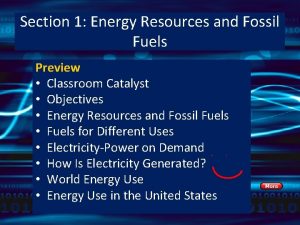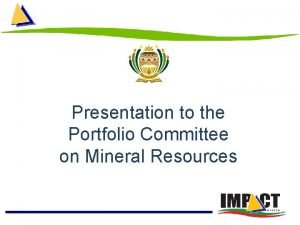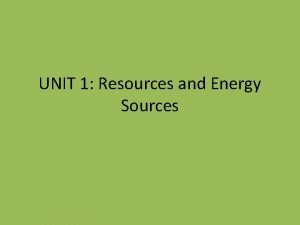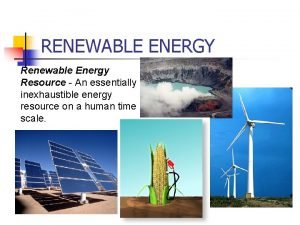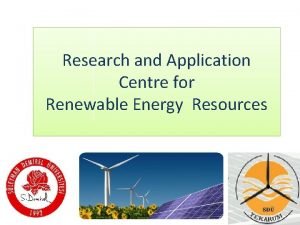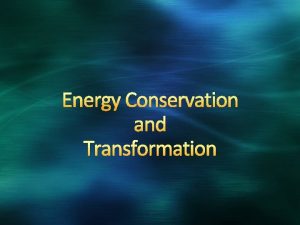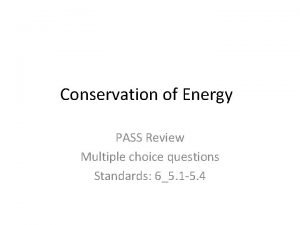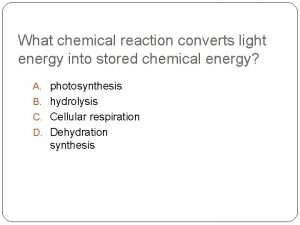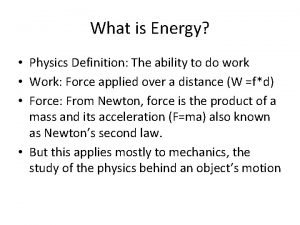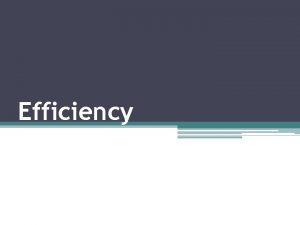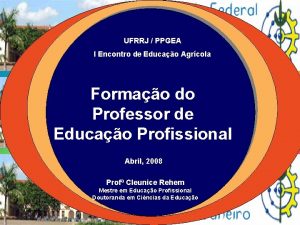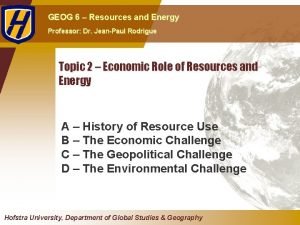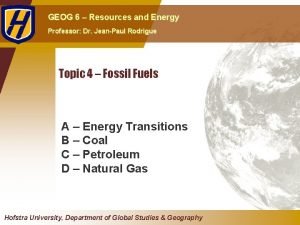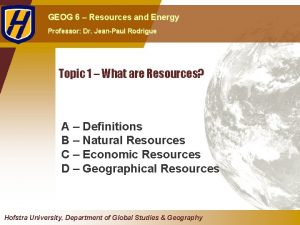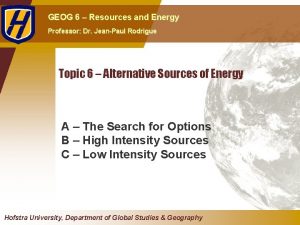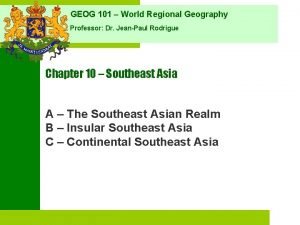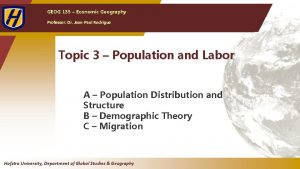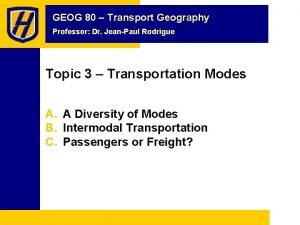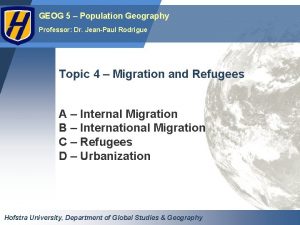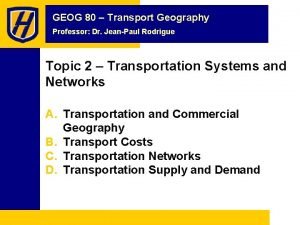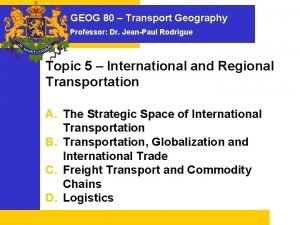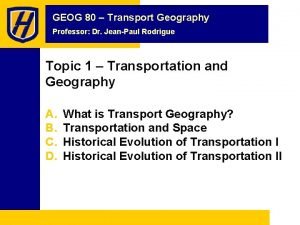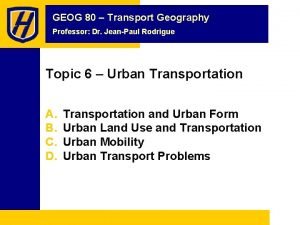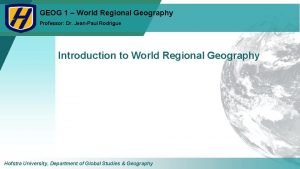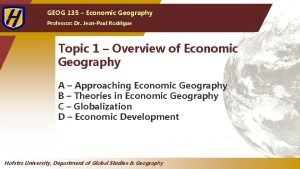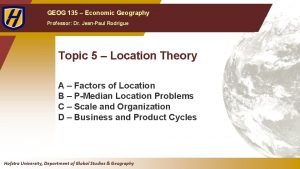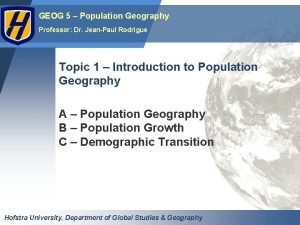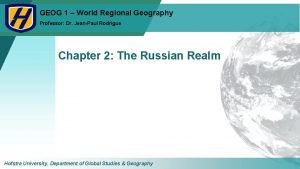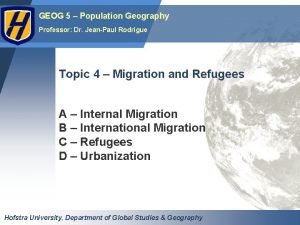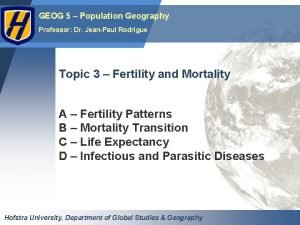GEOG 6 Resources and Energy Professor Dr JeanPaul





































































- Slides: 69

GEOG 6 – Resources and Energy Professor: Dr. Jean-Paul Rodrigue Topic 3 – Agriculture and Food A – Food Models B – Food Production and Trade C – The Green Revolution and Food Security Hofstra University, Department of Global Studies & Geography

A. FOOD MODELS 1. The Human Diet 2. Nutrition Transitions 3. Malnutrition © Dr. Jean-Paul Rodrigu

1. The Human Diet ■ The human diet • Minimum caloric requirement: • 2, 700 calories for men and 2, 000 calories for women. • Diet is organized along models: • No single food can supply human needs in protein, vitamins and amino acids. • Result of the socio-economic environment of the population: • About 15 plants and 8 animal species supply 90% of food. • Commonality of some food components in different parts of the world. • Related to an average daily calorie intake. • Linked to agricultural practices, but also to agribusiness and food processing industries. • Factors: • Income (quantity, quality, meat consumption). © Dr. Jean-Paul Rodrigu

Annual Per Capita Consumption of Livestock Products in Selected Countries, 1998 (in kilograms) India China Mutton Poultry Pork Beef Italy United States 0 10 20 30 40 50 © Dr. Jean-Paul Rodrigu

1. The Human Diet ■ The “Fast Food” diet • Growing involvement of corporate interests. • Higher sugar and fat content: • Value added and high profits food products. • Low satiation level. • Fast food industry: • Largest group of minimum wage workers in the US (3. 5 million). • 25% of the adult population visit a fast food restaurant every single day. • Most fast food is delivered to the restaurant already frozen, canned, dehydrated, or freeze-dried. • A fast food kitchen is merely the final stage in a vast and highly complex system of mass production. © Dr. Jean-Paul Rodrigu

Number of Mc. Donald’s per Country, 2004 1, 154 12, 804 31, 000 Mc. Donalds restaurants worldwide (2009), employing 1. 5 million people. 3, 598 © Dr. Jean-Paul Rodrigu

Main Elements of Kraft’s Portfolio © Dr. Jean-Paul Rodrigu

1. The Human Diet 140 ■ “Supersizing” Profit • Larger containers and quantities: Syrup 120 100 137 80 120 60 • Little cost for the supplier: 40 20 0 • Larger package size can increase consumption up to 55%. • 1950 s: The standard Coca -Cola container was 6. 5 ounces. • 1990 s: The standard Coca -Cola container was 20 ounces. 9 12 Medium Coke Large Coke • Brand name, packaging and marketing are dominant in pricing. • Larger quantities directly means higher profits. • Skew the perception of © Dr. Jean-Paul Rodrigu

1. The Illusion of Diversity, Ownership of the Soft Drink Industry, United States Coca Cola (42. 8%) Pepsi (31. 1%) Dr Pepper Snapple Group (15%) Coca Cola Honest Tea Desani Powerade Nestea Glaceau Fuze Fanta Minute Maid Sprite Fresca Mr. Pibb Pepsi Aquafina Mountain Dew Sierra Mist Gatorade Lipton Oceanspray Tropicana Dole Sobe Life Water Snapple A&W Big Red Nantucket Nectars Seven Up Crush Dr Pepper Accelerade Hawaiian Punch Welch’s Canada Dry Sunkist Schweppes Orangina © Dr. Jean-Paul Rodrigu

1. Consumption of Coca-Cola Beverages per Capita (Liters) Mexico Chile United States Australia Argentina Spain South Africa Canada Germany Japan Italy Philippines France Poland World Thailand Russia China Nigeria Indonesia India 2008 1998 1988 0 20 40 60 80 100 120 140 160 © Dr. Jean-Paul Rodrigu

2. Nutrition Transitions ■ Nutrition Transition Share of the Population Underweight and Overweight • Urban and sedentary: • People are more often away from home. • 1970: 75% of all food expenses spent to prepare meals at home. • 2000: 50% of all food expenses for restaurants. • Element of time. Developed countries Economies in transition • More woman in the labor force: DC • Away from the traditional role of food preparation. • Both members of a couple are often working. Overweight LDC Underweight 0 5 10 15 20 25 • Less preparation time available: • 90% of the money spent © Dr. Jean-Paul Rodrigu

Time Spent Preparing Food at Home, UK (1934 -2010) 160 140 Traditional cooking 120 Minutes 100 80 Modern appliances 60 40 20 Prepared food Fresh and frozen food Home deliveries 0 1924 1934 1944 1954 1964 1974 1984 1994 2004 2014 2024 © Dr. Jean-Paul Rodrigu

2. Evolution of the Japanese Diet (kg / capita / year) 400 350 Oils & Fats 300 Fish & Shellfish 250 Milk & Dairy Products Eggs 200 Meat Wheat 150 Rice 100 Grains 50 0 1936 1960 1970 1995 © Dr. Jean-Paul Rodrigu

2. Nutrition Transitions ■ Changes in the diet • Nutritional shift: • From a diet dominated by grains and vegetables to a diet dominated by fats and sugars. • Natural human desire for fat and sugar (energy dense foods; low satiation). • Between 1980 and 2000 calorie intake in the US has risen nearly 10% for men and 7% for women. • Increased corporate involvement in food supply: • Caffeine is added (75% of sodas) to provide addiction. • Massive usage of flavoring. • Homogenization of global diets: • Global cultural diffusion. • Outcome of trade. • Fast food industry. © Dr. Jean-Paul Rodrigu

2. Food expenditures by families and individuals as a share of disposable personal income, 1929 -2009 30 25 45% At home 40% Away from home 35% 20 30% 25% 15 20% 10 15% 10% 5 5% 0% 19 2 19 9 3 19 3 3 19 7 4 19 1 4 19 5 4 19 9 5 19 3 5 19 7 61 19 65 19 69 19 73 19 77 19 81 19 85 19 89 19 93 19 9 20 7 0 20 1 0 20 5 09 0 © Dr. Jean-Paul Rodrigu

3. Malnutrition ■ Malnutrition • Imbalance (deficit or excess) in intake of nutrients. • Hunger: • Deficiency of calorie and protein. • At least 1. 2 billion people affected. • Micronutrient deficiency: • Deficiency of vitamins and minerals. • People in developing countries eat primarily staple grain crops and do not get enough protein. • 2. 0 billion affected. • Overconsumption: • • Excess of calories. Often accompanied by vitamins and minerals deficiencies. At least 1. 2 billion people affected. 300 million people are obese. © Dr. Jean-Paul Rodrigu

Share of Underweight Children and Overweight Adults, Selected Countries, Mid 1990 s Brazil Indonesia Colombia Nigeria Germany Viet Nam UK Ethiopia Russia India United States Bangladesh 0 20 40 60 © Dr. Jean-Paul Rodrigu

3. Malnutrition ■ Obesity • Significant growth of the share of adults that are overweight. • BMI (Body Mass Index): • • • Weight in kilograms, divided by the square of height in meters. 18 -25: Normal. 25 -30: Overweight. 30 -40: Obese Above 40: Morbidly obese. • More prevalent among the poor (fat and sugar). ■ “Generation XXL” • Supersizing. • Lack of physical activities. • High fat and sugar diet. © Dr. Jean-Paul Rodrigu

3. Past and Projected Overweight Rates in Selected OECD Countries 80% 70% France 60% England Austria Italy 50% Canada Korea 40% Australia USA 30% 20% 1970 1980 1990 2000 2010 2020 © Dr. Jean-Paul Rodrigu

3. Body Mass Index of Selected Countries – “Globesity” Japan Egypt Norway Italy Austria France Poland Belgium Turkey Spain Canada Hungary New Zealand Australia United Kingdom Mexico USA 0 5 10 15 20 25 % of population over 25 with a BMI of 30+ 30 35 © Dr. Jean-Paul Rodrigu

3. Share of Overweight Children, Selected Countries United States (2004) 6 -17 UK Scotland (2008) 12 -15 Spain (2000) 13 -14 Italy (2006) 8 -9 New Zealand (2002) 5 -14 Mexico (2006) 5 -17 UK England (2004) 5 -17 Canada (2004) 12 -17 Australia (2007) 9 -13 Israel (2007) 5 -7 Chile (2000) 6 Korea (2005) 10 -19 Brazil (2002) 7 -10 Sweden (2001) 6 -13 Belgium (2005) 4 -15 Germany (2002) 5 -17 France (2006) 11 -17 South Africa (2004) 6 -13 China (2004) 6 -11 Netherlands (2003) 5 -16 Japan (2000) 6 -14 Russia (2004) 10 -18 India (2002) 5 -17 Turkey (2001) 12 -17 Indonesia (2000) 10 -18 0 5 10 15 20 25 30 35 40 © Dr. Jean-Paul Rodrigu

3. Malnutrition ■ Diet-related diseases • Cardiology, endocrinology (diabetes), neurology, psychiatry, dermatology, gastrointestinal, oncology, respirology. • 300, 000 Americans die prematurely each year as a result of being overweight. • Americans spend 40 billion per year on weight-loss products and services. • Weight-loss products have been linked with growing obesity. • People simply eat more “fat-free” products. © Dr. Jean-Paul Rodrigu

3. Malnutrition ■ Hyperinsulinemia • • Related to chronic consumption of sugar. Leads to over-production of insulin. Development of a carbohydrate intolerance. Gains weight, while being hungry most of the time (specifically craving sugars) and lacking in energy. • The body then lowers its activity level in response to what it perceives as a state of starvation. © Dr. Jean-Paul Rodrigu

B. FOOD PRODUCTION AND TRADE 1. 2. 3. 4. Agriculture Food Production International Food Trade Global Challenges © Dr. Jean-Paul Rodrigu

1. Agriculture Geological Soil conditions. p. H range. Climatic Temperature and precipitation. Food yield Seeds, fertilizers, equipment. Economic Labor, capital, demand. Access Political and infrastructure impediments. End-use Making food available to consumers. Biocapacity Weeds Pests Pathogens Floods, storms Droughts Conflict Poverty Transport Processing Distribution Storage Preparation © Dr. Jean-Paul Rodrigu

1. Length of Growing Period (LGP) Combines temperature and moisture considerations to determine the length of time crops are able to grow. Number of days with temperatures above 5°C. Excluding periods which are too cold or too dry or © Dr. Jean-Paul Rodrigu both.

1. Most Suitable Cereal © Dr. Jean-Paul Rodrigu

1. Main Agriculture Models Subsistence farming Food mainly grown to support the family / community. Variety of plants and animals cultivated. Surpluses sold on local markets, often to pay taxes and buy simple goods. Limited level of technology and capital investment. Commercial agriculture Mostly owned by family interests (SME). Food mainly grown for local/national markets, with some exports. Specialization of crops (economies of scale). Average level of technology and capital investment. Corporate farming Food grown for global markets, but in many case regionally. Usage of subcontractors (commercial farmers). Emphasis on product development, branding and marketing. Specialized cash crops (coffee, bananas, cacao, sugar, etc. ) for plantations. Often control several elements of the supply chain (seeds, transformation). © Dr. Jean-Paul Rodrigu

2. Patterns of Global Food Production Globalization Global markets. Exchange of food cultures. Long trade routes. Non-renewable energy Food production, transformation and distribution. Market concentration Large multinational agro-firms. Control of technical expertise (intellectual property). Retailers becoming grocers. Monoculture Improved yield. Increased dependency on fertilizers and irrigation. Biodiversity risk. Aquaculture Try to replace exhausted fish supplies. More rational use of oceanic resources. Protein transition Gradual shift to lower quality sources of protein. From beef to pork and poultry. © Dr. Jean-Paul Rodrigu

A Declining Food Variety © Dr. Jean-Paul Rodrigu

2. World Protein Production by Source, 1950 -2005 500 450 400 350 Aquaculture 300 Seafood 250 Eggs 200 150 100 Poultry Mutton Pork Beef 50 19 55 19 60 19 65 19 70 19 75 19 80 19 85 19 90 19 95 20 00 20 05 0 © Dr. Jean-Paul Rodrigu

2. Energy Content and Food Production Food Calories / Lbs. Energy (k. Wh) to Produce 1 Lbs. Energy Efficiency Corn 390 0. 43 102% Milk 291 0. 75 45% Cheese 1824 1. 67 31% Eggs 650 4 19% Apples 216 4. 4 15% Chicken 573 6. 75 15% Pork 480 12. 6 8. 5% Beef 1176 31. 5 4. 3% © Dr. Jean-Paul Rodrigu

2. Grain Equivalent to Produce Meat (in kg) Poultry Pork Beef 0 2 4 6 8 © Dr. Jean-Paul Rodrigu

2. Food Production ■ Shrimp farming • Thailand is the world’s largest exporter and second largest producer. • Shrimp is one of the most consumed seafood: • Cheap; fast growth cycle. • Can be grown using aquaculture. • Marine shrimp: • • Southeast Asia very suitable; substantial tropical coastline. Grown in ponds along coastal areas. Filled with saltwater pumped from the ocean. Shrimp ready for harvest in 90 to 120 days. • Ecological issues: • Some mangrove forests cleared. • Replace a diverse ecosystem with monoculture. • Waste water can be a source of pollution. © Dr. Jean-Paul Rodrigu

■ Tilapia farming © Dr. Jean-Paul Rodrigu

3. International Food Trade ■ International trade of agricultural goods • About 9% of global exchanges in commodities. • Nature, origin and destination of food trade: • • If the good is perishable. Consumption habits. The profit that can be derived from trading food products. Highly linked to export cultures that are produced strictly to generate income. • Third World countries are massively involved in these types of cultures. • Overcome shortages: • Import what is lacking in the national production. • An economy needs to generate sufficient surpluses from other sectors. • Purchase enough food to overcome the national deficit. • Very few Third World countries can afford to do so. © Dr. Jean-Paul Rodrigu

3. Global Exports of Merchandises, 1963 -2008 100% 80% 60% Manufactured products Mineral products 40% Agricultural products 20% 0% 1963 1975 1990 1994 2000 2007 2008 © Dr. Jean-Paul Rodrigu

3. Exports of Cereals, 1960 -2007 (in 1000 s of tons) 350, 000 World Australia 300, 000 Argentina 250, 000 France 200, 000 150, 000 100, 000 50, 000 99 20 01 20 03 20 05 20 07 7 19 5 19 9 3 19 9 1 19 9 9 19 9 7 19 8 5 19 8 3 19 8 1 19 8 9 19 8 7 19 7 5 19 7 3 19 7 69 19 67 19 65 3 19 19 6 1 0 © Dr. Jean-Paul Rodrigu

3. Grain Imports for Selected Countries, 1990, With Projected Need for Imported Grain in 2030 Pakistan 2030 Nigeria 1990 Mexico Iran Indonesia India Ethiopia & Eritrea Egypt 215 China Brazil Bangladesh 0 10 20 Million tons 30 40 50 © Dr. Jean-Paul Rodrigu

3. World Coffee Production and Trade, 2003 65% of supply from three countries (Brazil, Columbia and Vietnam) Sugar Cocoa Share of Developing countries in global exports of agricultural goods, 2000 Coffee Bananas Pepper Tea 0 20 40 60 80 100 © Dr. Jean-Paul Rodrigu

3. Price of Coffee, 1980 -2010 ICO Composite (Cents per pound) 250 1) Demand constant and steadily increasing (2. 5% PY). 2) Supply concentration (weather risk). 3) Hoarding when prices start to increase. 200 150 100 50 0 n 1 Ja n 0 8 6 Ja n 0 4 Ja n 0 2 Ja n 0 0 Ja n 0 8 Ja n 9 6 4 Ja n 9 2 Ja n 9 0 Ja n 9 Ja n 8 8 6 Ja n 8 4 Ja n 8 2 Ja n 8 Ja Ja n 8 0 0 © Dr. Jean-Paul Rodrigu

Coffee and Cocoa Production by Developing Countries and Imports by Developed Countries, 1961 -2001 (in tons) 8, 000 7, 000 Coffee production (Developing) 6, 000 Cocoa production (Developing) 5, 000 4, 000 3, 000, 000 2001 1999 1997 1995 1993 1991 1989 1987 1985 1983 1981 1979 1977 1975 1973 1971 1969 1967 1965 1963 0 1961 1, 000 © Dr. Jean-Paul Rodrigu

4. Some Challenges Facing Agriculture Economic Social Environmental Production Conversion of farmland to other uses. Productivity of smaller operations. Illegal workers (+ 50% in US). Aging of farmers. Land ownership. Soil depletion. Aquifer depletion. Loss of biodiversity. Pests. Climate change. Consumptio n Costs of diet related diseases. Overconsumption One quarter of food and obesity. discarded. Packaging and waste. Distribution High marketing costs Less preparation. (80%). Industry oligopoly. Long distances to markets. 7 to 10 units of energy consumed to produce one unit of food energy. © Dr. Jean-Paul Rodrigu

4. Global Challenges ■ Maintaining agricultural output • Context of increased food demand. • Provide food for the expected population surge of 1. 5 billion people between 2000 and 2020. • Expansion of land under cultivation. • Intensified cultivation; • Higher productivity per unit of surface. • Efforts aimed at intensified cultivation are now much more critical than only 20 years ago. • Coping with changes in diet patterns (more meat): • One pound of feedlot beef: 2, 500 gallons of water, 12 pounds of grain, energy equivalent of one gallon of gasoline. © Dr. Jean-Paul Rodrigu

61 19 6 19 3 6 19 5 6 19 7 6 19 9 7 19 1 73 19 7 19 5 7 19 7 7 19 9 8 19 1 8 19 3 85 19 8 19 7 8 19 9 9 19 1 9 19 3 9 19 5 9 19 7 9 20 9 0 20 1 0 20 3 0 20 5 0 20 7 09 19 Millions 4. Meat Production, United States and China 1961 -2009 (in tons) 90 80 China United States 70 60 50 40 30 20 10 0 © Dr. Jean-Paul Rodrigu

4. Global Challenges ■ Expansion potential • Reserves still exist in the developing countries for expanding agricultural land. • Very unevenly distributed: • Found mainly in Latin America and Sub-Saharan Africa. • Asian countries, especially the most densely populated, have only slight expansion possibilities. • Demographic pressure pushes towards that strategy. • Fishing: • Was believed that the oceans provided an unlimited supply. • “Peak fish” was reached around 1980. • The potential of aquaculture remains uncertain: • Conversion of grain. • Waste generation. © Dr. Jean-Paul Rodrigu

4. Global Challenges ■ Consequences • Rapidly deterioration of environmental quality. • Extended soil degradation: • Nutrient depletion. • Erosion. • Salination. • Dwindling availability of water resources: • Agriculture accounts for 70% of all fresh water withdrawals. • Exhaustion of aquifers. • Water pollution by fertilizers and pesticides. • Loss of animal and plant species (biodiversity): • 20 to 30% of the world’s forest converted to agriculture. • 50% of all species are in danger of extinction. • Threatening national parks and protected areas. © Dr. Jean-Paul Rodrigu

C. THE GREEN REVOLUTION AND FOOD SECURITY 1. The Green Revolution 2. Food Security and Food Aid © Dr. Jean-Paul Rodrigu

1. The Green Revolution ■ Context • Strong population growth in the second half of the 20 th century. • New techniques were required to increase production. • New land was becoming scarce. • Labor was difficult to add to existing agricultural systems. ■ Increasing the agricultural output • Green Revolution in the 1960 s. • New varieties of wheat, corn and rice: • 1920: 20 bushels per acre (wheat). • 1997: 120 bushels per acre (wheat). • Enabling up to three harvests per year and increased outputs. © Dr. Jean-Paul Rodrigu

1. The Green Revolution ■ Strategy • Focused more on scientific achievements rather than on mechanization of agriculture. • Focused on genetics and pedology (soil science). • The development of new seed strains: • • Increase agricultural production. Make crops more resistant to diseases. Development of hybrids. New strains do not occur naturally. • The improvement of inputs into soils: • • Fertilizers of various types. Enhance the productivity of previously marginal soils. Irrigation in dry areas (40% of our food comes from irrigation). Boost productivity in many world regions but not without costs. © Dr. Jean-Paul Rodrigu

1. Fertilizer Response Curve for Corn 95 Yield (bushels/acre) 90 85 80 75 70 65 60 55 50 0 40 80 120 160 200 Pounds of nitrogen applied per acre © Dr. Jean-Paul Rodrigu

1. The Green Revolution ■ Net impact • Increased agricultural output in many areas: • Yields were more than doubled for many cereals (wheat, maize and rice). • Increased the cost of agriculture: • Bioengineered seeds. • Fertilizers and pesticides. • Equipment. • Decreased agricultural employment: • Benefits accrued to the wealthier and middle class farmers who could afford its more costly inputs. • Increased landlessness among the peasantry. • Increased surplus population in rural areas: • Increased rural to urban migration in many developing countries. © Dr. Jean-Paul Rodrigu

19 6 19 1 6 19 3 6 19 5 6 19 7 6 19 9 7 19 1 7 19 3 7 19 5 7 19 7 7 19 9 8 19 1 8 19 3 8 19 5 8 19 7 8 19 9 9 19 1 9 19 3 9 19 5 9 19 7 9 20 9 0 20 1 0 20 3 0 20 5 0 20 7 09 Millions 1. Global Production of Major Grains, 1961 -2009 (in M tons) 2500 2000 Maize (Corn) Rice Wheat 1500 1000 500 0 © Dr. Jean-Paul Rodrigu

1. Global Cereal Yields, 1961 -2005 (kg per hectare) 60, 000 50, 000 Maize/Co rn 40, 000 30, 000 20, 000 0 1961 1963 1965 1967 1969 1971 1973 1975 1977 1979 1981 1983 1985 1987 1989 1991 1993 1995 1997 1999 2001 2003 2005 2007 2009 10, 000 © Dr. Jean-Paul Rodrigu

1. Change in Cereal Yields, 1965 -2002 Cereal Output per Hectare, 2000 (kg) © Dr. Jean-Paul Rodrigu

70, 000 400 India Yield (kg / hectare) 60, 000 350 China Yield (kg / hectare) Millions 1. Production and Yield of Rice in China and India, 19612009 India (tons) 50, 000 300 China (tons) 250 40, 000 200 30, 000 150 20, 000 10, 000 50 0 19 61 19 63 19 65 19 67 19 69 19 71 19 73 19 75 19 77 19 79 19 81 19 83 19 85 19 87 19 89 19 91 19 93 19 95 19 97 19 99 20 01 20 03 20 05 20 07 20 09 0 © Dr. Jean-Paul Rodrigu

50, 000 45, 000 40, 000 35, 000 250 India Yield (kg / hectare) China Yield (kg / hectare) India (tons) Millions 1. Production and Yield of Wheat in China and India, 1961 -2009 200 China (tons) 30, 000 150 25, 000 20, 000 15, 000 10, 000 50 5, 000 0 19 61 19 63 19 65 19 67 19 69 19 71 19 73 19 75 19 77 19 79 19 81 19 83 19 85 19 87 19 89 19 91 19 93 19 95 19 97 19 99 20 01 20 03 20 05 20 07 20 09 0 © Dr. Jean-Paul Rodrigu

1. The Green Revolution ■ The Green Revolution and economic dependency • Agriculture is now more capital intensive: • Requires irrigation systems, fertilisers and pesticides. • Often produced by multinational corporations. • A shift from subsistence to commercial and corporate agriculture. • Consumes a lot of oil. • Financing agriculture: • Increasing linkages with financial institutions. • Borrowed money to purchase inputs, fell into debt, and lost their land to creditors when they were unable to pay. • Put the peasant in a debt cycle. • In many areas the Green Revolution increased landlessness among the peasantry. © Dr. Jean-Paul Rodrigu

1. The Green Revolution ■ Future of agriculture? • Increase in global food trade. • Price and availability remain uncertain. • Improving the performance of plants and animals: • Genetic engineering; transgenic crops (high protein potatoes). • Controlled ripening (enzyme); tomatoes have a shelf life of 10 to 14 days. • Herbicide and fungal resistance. • Animal diet (increased absorption). • Improved nutrition (more amino acids, vitamins and easier digestion). • Modifying life to suit medical, industrial and energy purposes: • Disease fighters (bananas and potatoes delivering vaccine). • Biomanufacturing (colored cotton; plastic making corn; rubber making sunflower; hydrogen producing algae. ). © Dr. Jean-Paul Rodrigu

2. Food Security and Food Aid ■ Food security • State of affairs where people have access to safe and nutritious food to maintain a healthy and active life: • Quantitatively and qualitatively adequate food (70 days). • Affordability. ■ Dimensions • Availability: • Sufficient quantities of food of appropriate quality, supplied through domestic production or imports. • Access. • Optimal uptake: • Nourishment with a sustaining diet, clean water and adequate sanitation, together with health care. © Dr. Jean-Paul Rodrigu

2. World Grain Carryover Stocks (Days of Consumption) 100 90 80 70 60 50 40 30 20 10 0 1965 1970 1975 1980 1985 1990 1995 2000 © Dr. Jean-Paul Rodrigu

2. Days of Consumption of Global Grain Reserves, 2010 Soybeans Maize Wheat Rice 0 10 20 30 40 50 60 70 80 90 100 © Dr. Jean-Paul Rodrigu

2. Global Food Insecurity © Dr. Jean-Paul Rodrigu

2. Food Security and Food Aid ■ Factors a food Insecurity • • Fossil fuels dependency. Price fluctuations (particularly for imported food). Conflicts. Natural disasters. ■ Groups at risk • Displaced populations. • Low income households. • Dependent people: • Elderly. • Pregnant women. • Young children. © Dr. Jean-Paul Rodrigu

2. Number of Malnourished in the Developing World, 1970 -2015 (in millions) 1000 900 800 700 600 500 1970 1980 1995 2010 2015 © Dr. Jean-Paul Rodrigu

2. Food Security and Food Aid ■ Global Hunger Index • Multidimensional tool to assess hunger: • 1) Share of the proportion undernourished. • 2) Share of underweight children (less than 5). • 3) Infant mortality rate (less than 5). • On a scale from 0 to 100: • Less than 4. 9: low; 5 to 9. 9: moderate; 10 to 19. 9: serious; 20 to 29. 9: alarming; above 30: extremely alarming. © Dr. Jean-Paul Rodrigu

2. Changes in the Global Hunger Index, 1990 -2008 © Dr. Jean-Paul Rodrigu

2. Food Security and Food Aid ■ Food Aid • Several regions have chronic food shortages. • Several governmental and non-governmental agencies are organizing food aid programs. • Supply a temporary aid to the population in need. • Generally negative impacts such as the destruction of local agricultural systems. • Vicious circle of food aid favouring the persistence of problems in several nations. Famine Food Aid Drop in food prices Bankruptcy of Agriculture © Dr. Jean-Paul Rodrigu

16 14 12 10 8 6 Latin America Southern Asia Africa 4 2 7 19 0 7 19 2 7 19 4 7 19 6 7 19 8 8 19 0 8 19 2 8 19 4 8 19 6 8 19 8 9 19 0 9 19 2 9 19 4 9 19 6 9 20 8 0 20 0 0 20 2 0 20 4 06 0 19 Millions 2. Cereal Food Aid, Total and by Region, 1970 -2006 © Dr. Jean-Paul Rodrigu
 Promotion from associate professor to professor
Promotion from associate professor to professor Unit 1 geog. of ga/ga’s beginnings
Unit 1 geog. of ga/ga’s beginnings May subd geog
May subd geog Natural hazards definition ap human geography
Natural hazards definition ap human geography Dse geog essay sample
Dse geog essay sample Geog 214
Geog 214 Geog
Geog What is the transformative process of operations management
What is the transformative process of operations management Fixed resources definition
Fixed resources definition Energy energy transfer and general energy analysis
Energy energy transfer and general energy analysis Energy energy transfer and general energy analysis
Energy energy transfer and general energy analysis Renewable vs nonrenewable resources worksheet
Renewable vs nonrenewable resources worksheet Fossil fuel deposits
Fossil fuel deposits Portfolio committee on mineral resources and energy
Portfolio committee on mineral resources and energy Renewable resource def
Renewable resource def Energy resources student worksheet answers
Energy resources student worksheet answers Energy resources definition
Energy resources definition Chapter 12 nonrenewable energy resources
Chapter 12 nonrenewable energy resources Alternative energy sources definition
Alternative energy sources definition Biomass advantages
Biomass advantages Introduction about energy resources
Introduction about energy resources Work and energy section 2 describing energy answer key
Work and energy section 2 describing energy answer key Primary energy and secondary energy
Primary energy and secondary energy What is commercial energy source
What is commercial energy source Helmholtz free energy
Helmholtz free energy Renewable energy and energy efficiency partnership
Renewable energy and energy efficiency partnership Potential energy meaning
Potential energy meaning The change in mechanical energy
The change in mechanical energy Gravitational potential energy
Gravitational potential energy Potential energy units
Potential energy units Energy forms and energy conversions
Energy forms and energy conversions The professor and his beloved equation
The professor and his beloved equation Potential energy of a spring
Potential energy of a spring Gibbs free energy of formation
Gibbs free energy of formation Gibbs free energy non standard conditions
Gibbs free energy non standard conditions How to increase potential energy
How to increase potential energy Thermal energy vs heat energy
Thermal energy vs heat energy A hairdryer converts ____ energy into ____ energy.
A hairdryer converts ____ energy into ____ energy. Equation for energy
Equation for energy How to convert mechanical energy to electrical energy
How to convert mechanical energy to electrical energy Section 3 using heat worksheet answers
Section 3 using heat worksheet answers What is delta g
What is delta g As nutritional energy passes through the food chain it is
As nutritional energy passes through the food chain it is Usable chemical energy in food begins as __________ energy.
Usable chemical energy in food begins as __________ energy. Chapter 7 energy conservation of energy
Chapter 7 energy conservation of energy Wind energy is an indirect form of solar energy
Wind energy is an indirect form of solar energy ________ converts light energy into chemical energy. *
________ converts light energy into chemical energy. * Gravitational
Gravitational Potential energy examples
Potential energy examples Work electric potential energy formula
Work electric potential energy formula Energy physics
Energy physics Examples of mechanical energy
Examples of mechanical energy Gravitational potential energy vs kinetic energy
Gravitational potential energy vs kinetic energy Useful output power
Useful output power Mass and thermal energy
Mass and thermal energy Kinetic potential
Kinetic potential How do electric motors work
How do electric motors work In an energy pyramid where is the most energy
In an energy pyramid where is the most energy Photosynthesis transforms light energy into chemical energy
Photosynthesis transforms light energy into chemical energy Energy conversion of a toaster
Energy conversion of a toaster Chapter 8 section 1 how organisms obtain energy
Chapter 8 section 1 how organisms obtain energy Agamenon quimica
Agamenon quimica How to send a proper email to a teacher
How to send a proper email to a teacher Ll.1 correct capitalization errors answer key
Ll.1 correct capitalization errors answer key Perfil profissional professor
Perfil profissional professor Richard quinn ucf cheating
Richard quinn ucf cheating Ruth guthrie rate my professor
Ruth guthrie rate my professor Professor mso afskaffes
Professor mso afskaffes Mattie is a new sociology professor
Mattie is a new sociology professor Paraphrase in a sentence
Paraphrase in a sentence












